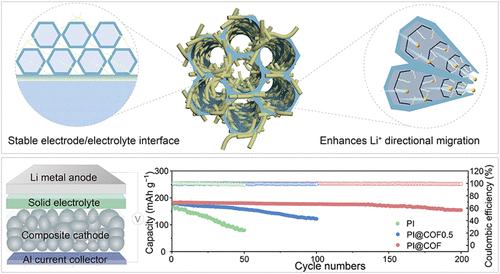Homologous Imide Bonds to Build Polymer-Covalent Organic Framework Electrolytes for Efficient Ion Transport
IF 15.6
1区 化学
Q1 CHEMISTRY, MULTIDISCIPLINARY
引用次数: 0
Abstract
A critical challenge for the safe operation of next-generation lithium (Li) metal batteries lies in the development of the key enabler of solid electrolytes. Herein, a polymer-covalent organic framework (COF) electrolyte with homologous imide bonds was designed and developed for safe and stable solid-state Li metal batteries. The imide-bonded COFs with ordered channels function as Li+ selective gates and conduction bridges, facilitating efficient ion transport while maintaining structural stability. Meanwhile, the fluorinated polyimide (FPI) polymer enriched with imide bonds contributes to the mechanical robustness, flexibility, and interfacial compatibility with Li metal electrodes, mitigating dendrite growth and improving long-term cycling stability. Owing to the synergistic effect between the COF and polymer, the polymer-COF delivers an ionic conductivity of 3.3 × 10–4 S cm–1 with a transference number of 0.82 and a wide electrochemical stability window. Besides, the polymer-COF solid electrolyte displays stable Li plating/stripping behavior over 2000 h, benefiting from superior interfacial compatibility. The applications of polymer-COF solid electrolytes in Li//LiNi0.8Co0.1Mn0.1O2 batteries further demonstrate that high Coulombic efficiency (>99.0%) and long life (>200 cycles) can be achieved. This design opens new routes to develop room-temperature solid electrolytes for high-performance solid batteries.

同源亚胺键构建高效离子传输的聚合物共价有机框架电解质
下一代锂金属电池安全运行的关键挑战在于固体电解质的关键使能剂的开发。本文设计并开发了一种具有同源亚胺键的聚合物共价有机框架(COF)电解质,用于安全稳定的固态锂金属电池。具有有序通道的亚胺键合COFs具有Li+选择门和传导桥的功能,在保持结构稳定性的同时促进了离子的高效传输。同时,富含亚胺键的氟化聚酰亚胺(FPI)聚合物具有机械稳健性、柔韧性和与锂金属电极的界面相容性,减缓了枝晶生长,提高了长期循环稳定性。由于COF与聚合物之间的协同作用,聚合物-COF的离子电导率为3.3 × 10-4 S cm-1,转移数为0.82,具有较宽的电化学稳定窗口。此外,聚合物- cof固体电解质在2000 h内表现出稳定的镀/剥离锂行为,这得益于优异的界面相容性。聚合物- cof固体电解质在Li//LiNi0.8Co0.1Mn0.1O2电池中的应用进一步证明,聚合物- cof固体电解质可实现高库仑效率(>99.0%)和长寿命(>;200次循环)。该设计为开发用于高性能固体电池的室温固体电解质开辟了新的途径。
本文章由计算机程序翻译,如有差异,请以英文原文为准。
求助全文
约1分钟内获得全文
求助全文
来源期刊
CiteScore
24.40
自引率
6.00%
发文量
2398
审稿时长
1.6 months
期刊介绍:
The flagship journal of the American Chemical Society, known as the Journal of the American Chemical Society (JACS), has been a prestigious publication since its establishment in 1879. It holds a preeminent position in the field of chemistry and related interdisciplinary sciences. JACS is committed to disseminating cutting-edge research papers, covering a wide range of topics, and encompasses approximately 19,000 pages of Articles, Communications, and Perspectives annually. With a weekly publication frequency, JACS plays a vital role in advancing the field of chemistry by providing essential research.

 求助内容:
求助内容: 应助结果提醒方式:
应助结果提醒方式:


